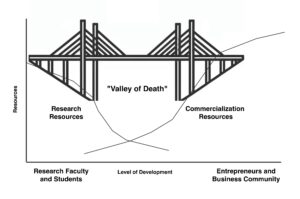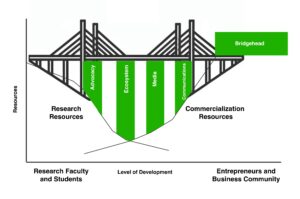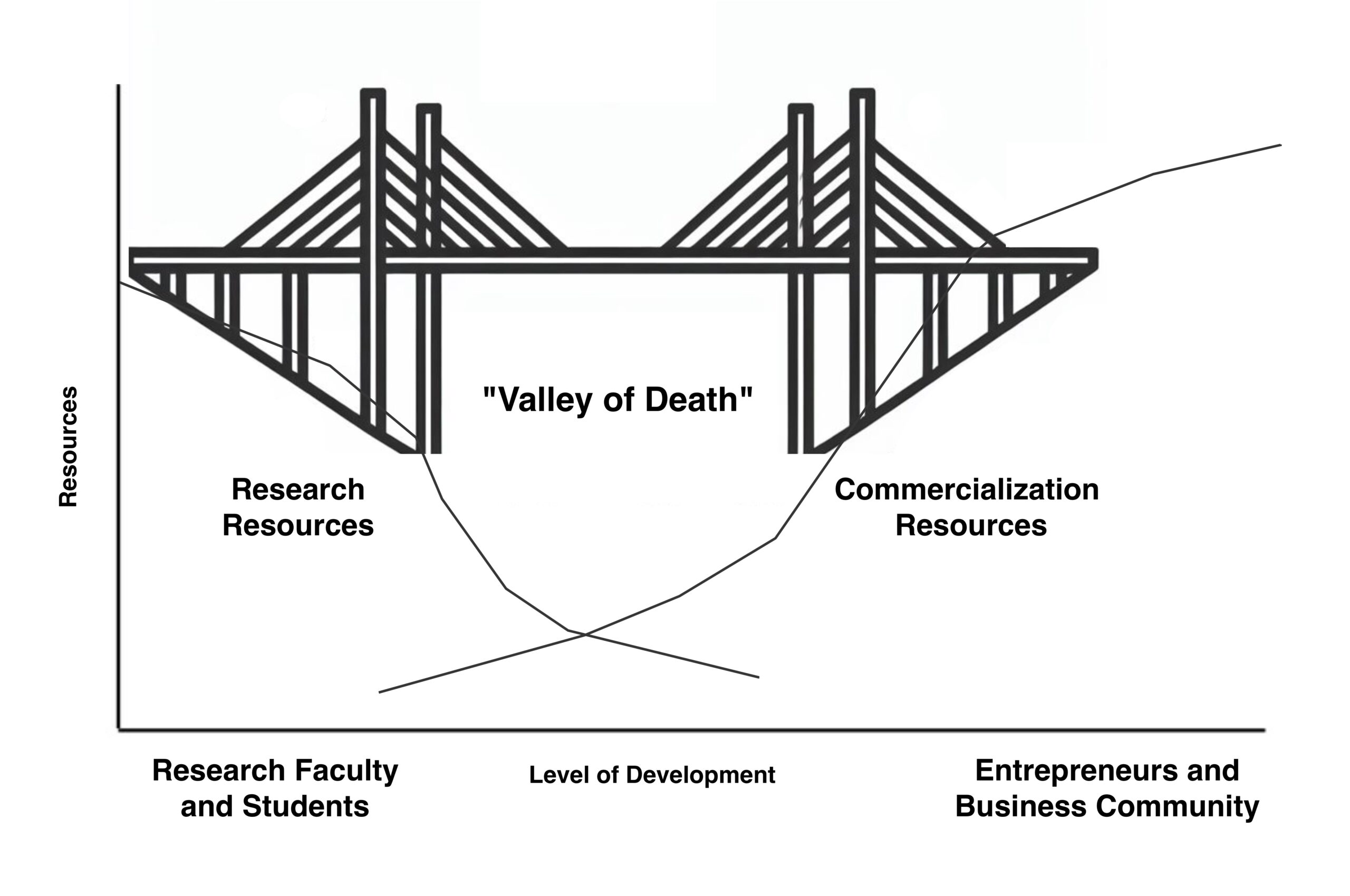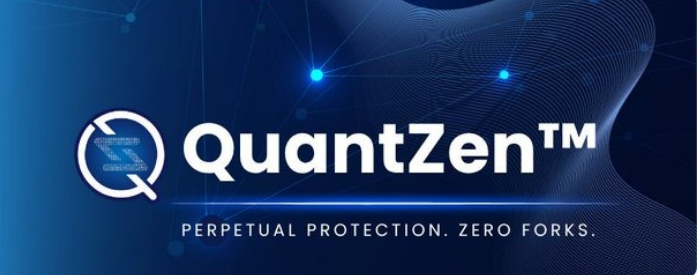By Mark M.J. Scott
President of Northern Pixels Inc.
Most deep tech start-up founders are aware of the dreaded Valley of Death, however too few founders heed the advice of experts who recommend to actively launch a commercial strategy while in the product development phase to improve the odds of success.
According to Boston Consulting Group’s November 2023 “An Investor’s Guide to Deep Tech”, the success rate of deep tech start-ups to reach C-Round funding is approximately 2%1. Little precise data exists on the success rate of deep tech start-ups in commercialization, but if we apply SaaS tech start-up data, (a more mature market), only 0.4% of start-ups achieve >$10M+ of sales2.

The Bridging the Valley of Death 2009 Article3 (Barr, Baker Markham, Kingon) argues that shaping curriculum and pedagogy to familiarize science and engineering graduate students with commercialization best practices, including identifying and prioritizing industries, use cases, and engaging with customers during the development phase can positively influence the success of start-ups led by students who become entrepreneurs.

Illustration from the Bridging the Valley of Death… article
In my experience crossing the Valley of Death is not enough, a deep tech early-stage commercialization strategy must be purposely designed to create a fortified position to launch the full phase commercialization – this is what I call a deep tech commercial bridgehead strategy.
Bridgehead strategy is a military term used to describe the utilization of specialized forces and tactics to secure a position on the opposite side of an obstacle (valley, river…) and then fortify that position to lunch into the next phase of operations. (Similar to the more commonly known term “beachhead strategy”, yet applicable to crossing a river/valley).
To achieve a significantly fortified commercial bridgehead I strongly advocate that prioritizing specific commercial investments that generate the highest payback. Planned and executed properly, this strategy fortifies a start-up’s position and improves the odds of securing additional funding for commercialization, accelerates market acceptance and time to revenue.
A key reason so many fail… misunderstanding commercialization strategy
Most deep tech founders do not fully understand the sophisticated and diverse tactics, of a commercialization strategy – therefore many wrongly believe all components of the strategy launch in parallel. This approach wastes valuable time and money – threatening ongoing viability and success of the start-up.
A well-orchestrated deep tech commercial strategy is launched in stages – marketing plays the key advance role in establishing a commercial bridgehead to create a powerful and fortified position for commercialization to launch from. In the early stages consider marketing as your special forces team with a clear mission to establish that bridgehead. Devised and executed properly, the strategy positions the start-up in a much stronger position for commercialization – accelerating partnerships, revenue and in many cases securing a leadership position in a new category that is very difficult for competitors to dislodge.
When the start-up launches into full commercialization, marketing’s prime objective should be sales pipeline generation. All aspects of marketing investments should be measured against the contribution of pipeline generated and closed sales. An experienced team will generate ~20X lifetime revenue (LTV) versus marketing campaign spending.
The key pillars supporting a deep tech Commercial Bridgehead strategy.
To establish the bridgehead and secure a fortified position on the other side of the Valley of Death there are four key supporting pillars you must prioritize – each interconnect into a comprehensive strategy that strengthens and accelerates your overall business strategy.
While some of these may appear obvious at first glance – I’ve witnessed very few deep tech start-ups deploy an effective combined strategy that maximizes the collective value of the four-pillar bridgehead.
A crucially important note here – contemporary AI solutions, foremost Perplexity, are transforming marketing and how to achieve awareness with different target markets. The assumption is you have guidance on how to leverage these contemporary tools to augment the strategies below. What may have been a reasonable awareness strategy developed in 2023 may no longer be effective today.

Advocacy
Advocacy is the foundation of success for all commercial innovation, particularly so for disruptive deep tech innovation. Your organization needs a clear advocacy plan that prioritizes the leading Key Opinion Leaders (KOL) from different sources: Academia, target industries, ecosystem related partners. The objectives and strategy for each are of course contextual.
You also need a marketing strategy that positions your organization as a rapidly growing and influential disruptive technology – the founder(s) must as well become key opinion leaders on the topic of how the technology will change the future.
Advocacy takes many forms; a seasoned marketing leader will not only be adept at identifying and engaging thought leaders but also devising which advocacy mediums are most likely to attract the target to participate and maximize the exposure.
Finally, a solid advocacy strategy is a gift that keeps giving. As your cohorts of influential advocates grow, they elevate your brand, the related advocacy content created becomes a powerful asset for supporting other strategic element of your strategy (see other pillars).
Target Industry Ecosystem
Identifying and engaging innovators within your target industry and cultivating symbiotic relationships at the earliest stages of your product development is crucial.
Start with the leading global brands, each advocate win with a global brand will attract more interest. The innovators most sought after are connected to specific strategic business (or government policy) objectives and are either in the boardroom or influence the boardroom.
Finally, each target industry has unique “Tech Stack” players, professional services firms, integrators, all of these become important players you must establish connections and awareness with at the earliest stages. Understand their value proposition and relationship with your target customers and craft an engagement strategy that bolsters their success alongside yours.
Media (target industry, business, general media and tech)
There’s a logical reason that media is positioned third on this list – the most effective media exposure will include support from your advocates and industry leaders. Your media engagement strategy will require multiple contextual tactics, based on the type of publications and desired outcomes. Below is a simplification of key media groups – but it helps illustrate the aspects of the required engagement strategy. Experienced marketing leaders will create a plan that leverages success from one group of media to another, scaling the success of the strategy with each win.
General media can rapidly and broadly deliver a level of brand awareness that can impact all aspect of your strategy and propel success with more vertical business and industry media. Additionally, general media is extraordinarily important if your technology is perceived as ominous (versus inspiring…) by the public, if so, you will need to build a compelling narrative to help influence ethical or regulatory challenges in your favor.
Business media is always hungry for stories related to how your disruptive technology will upset the status quo and transform industries, but if you’re looking for tier one business media exposure you will need to leverage your advocates to maximize exposure opportunities.
Industry media is obviously prioritized based on the target industries in your business plan, and require unique and well-developed media engagements as journalists will have a much deeper understanding of challenges, ecosystems, and competitors.
Tech media comes in multiple variants (tech category, industry, business, general public…) and it will play an important role in your success. Ensure your plan embraces tech media and keeps related editors and writers in the loop of your progress – context is crucial, consider their needs and audiences.
Communications momentum strategy – proactive, contextual streams.
To compensate for long product development timelines deep tech start-ups need to develop a communications momentum strategy to keep your target audiences engaged, inspired and loyal.
There’s a logical reason this is point four… effective plans involve repurposing and sharing content derived from the Pillar Strategies outlined above, each tailored to audience personas and their unique interests.
With communications content strategies, context is king. You have multiple unique audiences each with different objectives and needs – do not feed one stream of communications to multiple audiences, it will fail.
Cadence is crucial. You must establish a proactive communications plan with clear objectives, a defined cadence, and consistent implementation.
Mediums matter. Not all communications should be one-to-many; engaging and collaborating with prospect customers, analysts, professional services firms, and key opinion leaders can enhance message impact. Collaborative communication efforts such as live or web-based panel discussions on relevant trends and topics where valuable insights can be shared are highly beneficial.
When do you act? Listen to the experts… now.
As a deep tech founder, it’s normal to be preoccupied with technical hurdles of your product development at early stages, however as a founding leader you have a responsibility to your investors and your team to ensure all key strategies that drive a greater likelihood of success are explored and leveraged.
From my experience delivering multiple deep tech wins, a well-developed and executed Bridgehead Strategy provides outsized benefits compared to the investment; strengthens your position for subsequent funding rounds, helps attract and retain world leading talent, provides early customer feedback to shape, and accelerate your product development and it establishes a lucrative pipeline of customers willing to evaluate, purchase & evangelize your products.
About the author:
Mark M.J. Scott is President of Northern Pixels Inc. a firm specialized in improving and accelerating the success of deep tech start-ups. Mark has played a leadership role in growing multiple deep tech successes, including a cryptography company acquired by AppDirect, an Optics and Photonics company acquired by Toyota and a pioneering Enterprise Low Code Application Platform, Truecontext, where his strategy helped drive revenues to $30M ARR, it was acquired by Battery Ventures in 2024. Mark was recently hired by the Quebec, Canada Government’s Quantum Innovation Zone, $435M funded, to devise a commercial strategy to bolster start-up success.
REFERENCES
- An Investor’s Guide to Deep Tech November 2023, Jean-François Bobier, Anne-Douce Coulin, Constant Morez, Greg Emerson, Kaustubh Wagle, and Antoine Gourévitch
- Success Rate of Tech SaaS Start-ups: SaaStock: https://www.saastock.com
- Bridging the Valley of Death: Lessons Learned From 14 Years of Commercialization of Technology Education, 2009 Academy of Management Learning & Education, 2009, Vol. 8, No. 3, 370–388 STEVE H. BARR, TED BAKER, STEPHEN K. MARKHAM North Carolina State University ANGUS I. KINGON Brown University
For more market insights, check out our latest quantum computing news here.
















